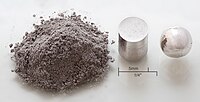
Photo from wikipedia
Bacillus megaterium strain MNSH1-9K-1, isolated from a high-metal content site in Guanajuato, Mexico, has the intrinsic capacity to remove vanadium (V) and nickel (Ni) from a petrochemical spent catalyst, and… Click to show full abstract
Bacillus megaterium strain MNSH1-9K-1, isolated from a high-metal content site in Guanajuato, Mexico, has the intrinsic capacity to remove vanadium (V) and nickel (Ni) from a petrochemical spent catalyst, and counteract the toxic effects produced in the cell due to the presence of oxidative stress. Since knowledge of the molecular components involved in the microbial resistance to spent catalysts is scarce, this study aimed to identify the proteins potentially involved in the enhanced resistance of a B. megaterium strain, during the removal of metals contained in a spent catalyst. Thus, the current research uses a proteomic approach to investigate and evidence the differences in the molecular resistance mechanisms of two B. megaterium strains, one isolated from a mining site and a wild type strain, when both are exposed to a spent catalyst. In addition, we studied their ability to eliminate nickel (Ni), vanadium (V), aluminum (Al) and molybdenum (Mo). The data presented here may contribute to the knowledge of the molecular mechanisms involved in the resistance of B. megaterium to high metal content wastes, as well as its potential utilization for the recovery of valuable industrial metals.
Journal Title: Biotechnology and Bioprocess Engineering
Year Published: 2017
Link to full text (if available)
Share on Social Media: Sign Up to like & get
recommendations!